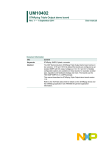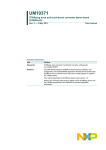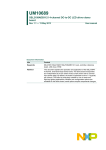Download UM10460 Low-cost 4 W mains LED driver for the Japanese market
Transcript
UM10460 Low-cost 4 W mains LED driver for the Japanese market using the TEA1523 Rev. 1 — 16 June 2011 User manual Document information Info Content Keywords TEA1523, SSL, low-cost, LED driver, AC/DC conversion, buck converter, driver, mains supply, user manual Abstract This is the user manual for the TEA1523 4 W LED driver demo board UM10460 NXP Semiconductors Low-cost 4 W mains LED driver using the TEA1523 Revision history Rev Date Description v.1 20110616 first issue Contact information For more information, please visit: http://www.nxp.com For sales office addresses, please send an email to: [email protected] UM10460 User manual All information provided in this document is subject to legal disclaimers. Rev. 1 — 16 June 2011 © NXP B.V. 2011. All rights reserved. 2 of 16 UM10460 NXP Semiconductors Low-cost 4 W mains LED driver using the TEA1523 1. Introduction WARNING Lethal voltage and fire ignition hazard The non-insulated high voltages that are present when operating this product, constitute a risk of electric shock, personal injury, death and/or ignition of fire. This product is intended for evaluation purposes only. It shall be operated in a designated test area by personnel qualified according to local requirements and labor laws to work with non-insulated mains voltages and high-voltage circuits. This product shall never be operated unattended. The 4 W TEA1523 buck converter board is a low-cost solution with an excellent price performance ratio. Only a minimum number of commercial off-the-shelf components are needed to build a fully functional LED driver that can be powered directly from the AC mains supply. The board can achieve an efficiency greater than 90 %. 1.1 Safety warning The board needs to be connected to 100 V mains voltage and it has no galvanic isolation between the mains and the LEDs. Touching the demo board during operation must be avoided at all times. An isolated housing for the board and the LEDs is mandatory when used in uncontrolled, non-laboratory environments. Therefore the board must be connected to the mains supply via a galvanic isolated (variable) transformer. These devices can be recognized by the symbols shown in Figure 1. 019aab174 019aab173 a. Isolated Fig 1. b. Not isolated Variac isolation symbols Remark: This board is for 100 V only, do not connect it to 230 V mains. 2. Connecting the board The board is optimized for a 100 V (AC) mains supply but it is also possible to operate it from a 120 V supply. The target load is a string of 24 LEDs with a total voltage of 68 V and an output current of 60 mA. The TEA1523 is supplied from the mains input voltage using a dVdt supply, removing the need for an auxiliary power supply. The board footprint is as small as possible requiring the fuse and the inrush resistor to be mounted outside the board. The LED string can be directly connected to the board. UM10460 User manual All information provided in this document is subject to legal disclaimers. Rev. 1 — 16 June 2011 © NXP B.V. 2011. All rights reserved. 3 of 16 UM10460 NXP Semiconductors Low-cost 4 W mains LED driver using the TEA1523 J3 J1 J2 J4 019aab698 (1) J1 and J2: 100 V (AC). (2) J3: LED+. (3) J4: LED. Fig 2. Board connection diagram 3. Power supply specification Table 1. UM10460 User manual Output specification Description Value Comment AC line input voltage 100 V, 10 % - output current (LED current) 60 mA see Figure 8 output LED voltage 68 V - LED current ripple 38 mA (42 %) see Figure 9. This ripple current has a 100 Hz component and a 100 kHz component. Maximum switching frequency 110 kHz - efficiency > 90 % see Figure 10 All information provided in this document is subject to legal disclaimers. Rev. 1 — 16 June 2011 © NXP B.V. 2011. All rights reserved. 4 of 16 UM10460 NXP Semiconductors Low-cost 4 W mains LED driver using the TEA1523 4. Board photographs 019aab699 a. Top view 019aab700 b. Bottom view Fig 3. UM10460 User manual Demo board views All information provided in this document is subject to legal disclaimers. Rev. 1 — 16 June 2011 © NXP B.V. 2011. All rights reserved. 5 of 16 UM10460 NXP Semiconductors Low-cost 4 W mains LED driver using the TEA1523 5. Functional description Although the TEA1523 is often promoted as a flyback controller, it is possible to use it as a non-isolated down converter (Ref. 1). Figure 4 shows the fundamental circuit of the buck converter. The buck converter that is described in this user manual is in the nominal operating range of 90 V to 110 V working in boundary conduction mode (BCM). D2 VLED L2 Vbus + S1 - CPAR 019aab701 Fig 4. Fundamental circuit The maximum value of the peak current is fixed in the design and the value of the LED current is calculated using Equation 1: ^ I I LED AV = ---2 (1) At higher bus voltages (> 113 V), the peak current is fixed by the design at VSOURCE(max) / RSOURCE = 0.5 V / 3 = 167 mA. At lower bus voltages, this peak current is not reached in time, making the LED current dependent on the bus voltage. This is shown in Figure 6 and Figure 7. UM10460 User manual All information provided in this document is subject to legal disclaimers. Rev. 1 — 16 June 2011 © NXP B.V. 2011. All rights reserved. 6 of 16 UM10460 NXP Semiconductors Low-cost 4 W mains LED driver using the TEA1523 019aab702 019aab702 (1) CH2: Vbus. (2) CH8: ILED. (3) Vmains = 100 V RMS. Fig 5. Vbus and ILED at 100 V RMS At higher bus voltages (> 150 V), the converter starts to work in Discontinuous Conduction Mode (DCM) and the LED current starts to drop. 019aab703 70 ILED (mA) 50 30 10 Fig 6. 80 120 160 Vbus (V) 200 Average LED current as a function of bus voltage Figure 6 shows the average LED current as a function of the bus voltage. The bus voltage was supplied from a DC source for this measurement, so there is no 100 Hz ripple. UM10460 User manual All information provided in this document is subject to legal disclaimers. Rev. 1 — 16 June 2011 © NXP B.V. 2011. All rights reserved. 7 of 16 UM10460 NXP Semiconductors Low-cost 4 W mains LED driver using the TEA1523 Figure 7 shows the circuit diagram based on the fundamental circuit shown in Figure 4. The input voltage is rectified and buffered in electrolytic capacitor C2. The larger the value of this capacitor, the larger the higher mains harmonics are. The combination of L1 and C2 prevents drawing high frequency currents from the mains. The TEA1523 is supplied by a dVdt supply that consists of C8 and (double) diode D3. The drain voltage is sensed via C9, R5 and R6 and supplied to the AUX input. This detects when the flux in inductor L2 reaches 0. The maximum switching frequency is set with C7 and R2. The peak current is set with R4 and Radj. The optional R3 and RT1 circuitry enables the implementation of an overtemperature protection. In this case, the REG pin is supplied with a fixed voltage that drops when the temperature of the circuit rises. An Negative Temperature Coefficient (NTC) resistor should be mounted at position RT1. UM10460 User manual All information provided in this document is subject to legal disclaimers. Rev. 1 — 16 June 2011 © NXP B.V. 2011. All rights reserved. 8 of 16 xxxx xxxxxxxxxxxxxxxxxxxxxxxxxxxxxx x xxxxxxxxxxxxxx xxxxxxxxxx xxx xxxxxx xxxxxxxxxxxxxxxxxxxxxxx xxxxxxxxxxxxxxxxxxxxxx xxxxx xxxxxx xx xxxxxxxxxxxxxxxxxxxxxxxxxxxxx xxxxxxxxxxxxxxxxxxxxxx xxxxxxxxxxx xxxxxxx xxxxxxxxxxxxxxxxxxx xxxxxxxxxxxxxxxx xxxxxxxxxxxxxx xxxxxx xx xxxxxxxxxxxxxxxxxxxxxxxxxxxxxxxx xxxxxxxxxxxxxxxxxxxxxxxx xxxxxxx xxxxxxxxxxxxxxxxxxxxxxxxxxxxxxxxxxxxxxxxxxxxxx xxxxxxxxxxx xxxxx x x LED+ D2 STTH2L06A C8 VIN1 J1 1 R1 1 VIN2 D3 BAV99 3 10 Ω 2 C1 n.m. J2 1 RV1 n.m. 1 2 L2 U1 F1 1.5 A C5 470 nF 220 pF 3 4 Z1 PZU24B C2 6.8 μF C3 100 nF VCC C6 1 μF GND C4 n.m. RC REG R2 10 kΩ C7 220 pF R3 270 kΩ RT1 shortout 1 8 2 7 TEA1523 3 4 6 5 1.5 mH DRAIN 1 J4 LED- C9 220 pF n.c. SOURCE R5 220 kΩ R7 AUX 22 kΩ R4 3Ω Radj n.m. R6 22 kΩ 019aab704 Schematic TEA1523 demo board UM10460 9 of 16 © NXP B.V. 2011. All rights reserved. Fig 7. Low-cost 4 W mains LED driver using the TEA1523 Rev. 1 — 16 June 2011 All information provided in this document is subject to legal disclaimers. D1 S1Z860 NXP Semiconductors 1 J3 6. Schematic TEA1523 demo board UM10460 User manual L1 300 μH UM10460 NXP Semiconductors Low-cost 4 W mains LED driver using the TEA1523 7. Bill of materials Table 2. Bill of materials Reference Description Value Manufacturer and Type Farnell number F1 fuse 1 A; 125 V Littelfuse; 0251001.MAT1L 9921974 R1 power resistor; thin film chip 10 Panasonic; ERG1SJ100A - RV1 not mounted - - - R2 SMD 0603; resistor 10 k Yageo; RC0603FR-0710KL 9238603 R3 SMD 0603; resistor 270 k Yageo; RC0603FR-07270KL 9238778 RT1 SMD 0603; resistor 0 Yageo; RC0603JR-070RL 9233130 R4 SMD 0805; resistor 3 KOA; SR732ATTD3R00F 1399723 Radj SMD 0603; resistor - - - R5 SMD 0805; resistor 270 k Yageo; RC0805FR-07220KL 9237917 R6 SMD 0603; resistor 220 k Yageo; RC0603FR-0722KL 9238646 R7 SMD 0603; resistor 220 k Yageo; RC0603FR-0722KL 9238646 C1 not mounted - - - C2 electrolytic capacitor 6.8 F Rubycon; BXC - C3 ceramic capacitor 100 nF MuRata; RDER72E104K3B1C11B - C4 not mounted - - C5 ceramic capacitor 470 nF MuRata; RDER72E474K5B1C13B - C6 SMD 0805; ceramic capacitor 1 F; 25 V Yageo; CC0805KKX7R8BB105 1458903 C7 SMD 0603; ceramic capacitor 220 pF; 50 V Yageo; CC0603JRNPO9BN221 430948 C8 SMD 1206; ceramic capacitor 220 pF; 200 V Yageo; CC0603JRNPO9BN221 1284139 C9 SMD 1206; ceramic capacitor 220 pF; 200 V Yageo; CC0603JRNPO9BN221 1284139 L1 inductor 390 H; 0.46 A; 0.86 Panasonic; ELC09D391F 8094926 L2 inductor with coil 1.5 mH; 0.43 A; 2.4 TDK; TSL1112S-152JR38-PF - D1 bridge rectifier; 1Z 0.6 A; 600 V Shindengen; S1ZB60 - D2 SMT diode 2 A; 600 V ST; STTH2L06A - D3 dual diode - NXP Semiconductors; BAV99 1081211 ZD2 Zener diode; SMT SOD323F 24 V NXP Semiconductors; PZU24B - UM10460 User manual All information provided in this document is subject to legal disclaimers. Rev. 1 — 16 June 2011 - © NXP B.V. 2011. All rights reserved. 10 of 16 UM10460 NXP Semiconductors Low-cost 4 W mains LED driver using the TEA1523 8. Measurements 8.1 Transformer schematic diagram Figure 8 to Figure 11 show measurements that were performed on the board. 019aab705 70 ILED (mA) 50 30 10 Fig 8. 50 70 90 110 130 Vmains (V) 150 LED current as a function of the 50 Hz mains voltage 019aab706 70 ILED(ripple)p-p (mA) 50 30 10 Fig 9. UM10460 User manual 50 70 90 110 130 Vmains (V) 150 Peak-to-peak ripple LED current as a function of the 50 Hz mains voltage All information provided in this document is subject to legal disclaimers. Rev. 1 — 16 June 2011 © NXP B.V. 2011. All rights reserved. 11 of 16 UM10460 NXP Semiconductors Low-cost 4 W mains LED driver using the TEA1523 019aab707 98 η (%) 94 90 86 50 70 90 110 130 Vmains (Vrms) 150 Fig 10. Efficiency of the converter as a function of the 50 Hz mains voltage Table 3. Mains conducted harmonic values Harmonic 120 V (AC); 50 Hz Harmonic 120 V (AC); 50Hz 1 100 % 11 29 % 2 - 12 - 3 83 % 13 21 % 4 - 14 - 5 58 % 15 9% 6 57 % 16 - 7 41 % 17 - 8 - 18 - 9 34 % 19 3% 10 - 20 - The Total Harmonic Distortion (THD) is 0.133 %. The value of the parasitic capacitance between drain and ground is calculated using Equation 2: ^ t C PAR = I ------V (2) The voltage across the internal MOSFET rises to 133 V during 240 ns. The maximum value of the peak current is 0.163 A. This results in a parasitic capacitance of 294 pF. UM10460 User manual All information provided in this document is subject to legal disclaimers. Rev. 1 — 16 June 2011 © NXP B.V. 2011. All rights reserved. 12 of 16 UM10460 NXP Semiconductors Low-cost 4 W mains LED driver using the TEA1523 RBW 9 kHz MT 1 ms PREAMP OFF NXP Semiconductors 12.Nov 10 17:11 Att 10 dB dBµV 100 kHz 100 LIMIT CHECK 1 MHz PASS 10 MHz 90 SGL 1 PK MAXH 80 2 AV CLRWR TDF 70 FCC15AVQ 60 50 FCC15BVQ 6DB 40 30 20 10 0 9 kHz 30 MHz 019aab708 a. Phase line. NXP Semiconductors 12.Nov 10 17:13 RBW 9 kHz MT 1 ms PREAMP OFF Att 10 dB dBµV 100 100 kHz LIMIT CHECK 1 MHz PASS 10 MHz 90 1 PK MAXH 2 AV CLRWR SGL 80 TDF 70 FCC15AVQ 60 50 FCC15BVQ 6DB 40 30 20 10 0 9 kHz 30 MHz 019aab709 b. Neutral line. Fig 11. Emission measurements UM10460 User manual All information provided in this document is subject to legal disclaimers. Rev. 1 — 16 June 2011 © NXP B.V. 2011. All rights reserved. 13 of 16 UM10460 NXP Semiconductors Low-cost 4 W mains LED driver using the TEA1523 9. Optimization TEA1523 demo board When operated at 100 V mains, a 100 Hz (or 120 Hz in case of 60 Hz mains) ripple on the LED current can be seen because at lower bus voltages, the maximum value of the peak current (Ipeak) is not reached. This can be solved by making the ripple voltage on the bus voltage smaller by increasing the value of the bus electrolytic capacitor. The penalty for this is that THD performance decreases. Another solution is to increase the value of R2 from 10 k to 12 k for example. This shifts the maximum operating frequency to a lower value and the maximum peak current is reached at a lower bus voltage. The bus voltage level at which the converter switches from BCM to DCM also shifts to a lower value. The LED voltage range is limited: the converter works efficiently when the LED voltage is about half the bus voltage. 10. References [1] UM10460 User manual AN00055 — STARplug Efficient Low Power supply with the TEA152x All information provided in this document is subject to legal disclaimers. Rev. 1 — 16 June 2011 © NXP B.V. 2011. All rights reserved. 14 of 16 UM10460 NXP Semiconductors Low-cost 4 W mains LED driver using the TEA1523 11. Legal information 11.1 Definitions Draft — The document is a draft version only. The content is still under internal review and subject to formal approval, which may result in modifications or additions. NXP Semiconductors does not give any representations or warranties as to the accuracy or completeness of information included herein and shall have no liability for the consequences of use of such information. 11.2 Disclaimers Limited warranty and liability — Information in this document is believed to be accurate and reliable. However, NXP Semiconductors does not give any representations or warranties, expressed or implied, as to the accuracy or completeness of such information and shall have no liability for the consequences of use of such information. In no event shall NXP Semiconductors be liable for any indirect, incidental, punitive, special or consequential damages (including - without limitation - lost profits, lost savings, business interruption, costs related to the removal or replacement of any products or rework charges) whether or not such damages are based on tort (including negligence), warranty, breach of contract or any other legal theory. Notwithstanding any damages that customer might incur for any reason whatsoever, NXP Semiconductors’ aggregate and cumulative liability towards customer for the products described herein shall be limited in accordance with the Terms and conditions of commercial sale of NXP Semiconductors. Right to make changes — NXP Semiconductors reserves the right to make changes to information published in this document, including without limitation specifications and product descriptions, at any time and without notice. This document supersedes and replaces all information supplied prior to the publication hereof. Suitability for use — NXP Semiconductors products are not designed, authorized or warranted to be suitable for use in life support, life-critical or safety-critical systems or equipment, nor in applications where failure or malfunction of an NXP Semiconductors product can reasonably be expected to result in personal injury, death or severe property or environmental damage. NXP Semiconductors accepts no liability for inclusion and/or use of NXP Semiconductors products in such equipment or applications and therefore such inclusion and/or use is at the customer’s own risk. Applications — Applications that are described herein for any of these products are for illustrative purposes only. NXP Semiconductors makes no representation or warranty that such applications will be suitable for the specified use without further testing or modification. Customers are responsible for the design and operation of their applications and products using NXP Semiconductors products, and NXP Semiconductors accepts no liability for any assistance with applications or customer product design. It is customer’s sole responsibility to determine whether the NXP Semiconductors product is suitable and fit for the customer’s applications and products planned, as well as for the planned application and use of customer’s third party customer(s). Customers should provide appropriate design and operating safeguards to minimize the risks associated with their applications and products. UM10460 User manual NXP Semiconductors does not accept any liability related to any default, damage, costs or problem which is based on any weakness or default in the customer’s applications or products, or the application or use by customer’s third party customer(s). Customer is responsible for doing all necessary testing for the customer’s applications and products using NXP Semiconductors products in order to avoid a default of the applications and the products or of the application or use by customer’s third party customer(s). NXP does not accept any liability in this respect. Safety of high-voltage evaluation products — The non-insulated high voltages that are present when operating this product, constitute a risk of electric shock, personal injury, death and/or ignition of fire. This product is intended for evaluation purposes only. It shall be operated in a designated test area by personnel that is qualified according to local requirements and labor laws to work with non-insulated mains voltages and high-voltage circuits. The product does not comply with IEC 60950 based national or regional safety standards. NXP Semiconductors does not accept any liability for damages incurred due to inappropriate use of this product or related to non-insulated high voltages. Any use of this product is at customer’s own risk and liability. The customer shall fully indemnify and hold harmless NXP Semiconductors from any liability, damages and claims resulting from the use of the product. Export control — This document as well as the item(s) described herein may be subject to export control regulations. Export might require a prior authorization from national authorities. Evaluation products — This product is provided on an “as is” and “with all faults” basis for evaluation purposes only. NXP Semiconductors, its affiliates and their suppliers expressly disclaim all warranties, whether express, implied or statutory, including but not limited to the implied warranties of non-infringement, merchantability and fitness for a particular purpose. The entire risk as to the quality, or arising out of the use or performance, of this product remains with customer. In no event shall NXP Semiconductors, its affiliates or their suppliers be liable to customer for any special, indirect, consequential, punitive or incidental damages (including without limitation damages for loss of business, business interruption, loss of use, loss of data or information, and the like) arising out the use of or inability to use the product, whether or not based on tort (including negligence), strict liability, breach of contract, breach of warranty or any other theory, even if advised of the possibility of such damages. Notwithstanding any damages that customer might incur for any reason whatsoever (including without limitation, all damages referenced above and all direct or general damages), the entire liability of NXP Semiconductors, its affiliates and their suppliers and customer’s exclusive remedy for all of the foregoing shall be limited to actual damages incurred by customer based on reasonable reliance up to the greater of the amount actually paid by customer for the product or five dollars (US$5.00). The foregoing limitations, exclusions and disclaimers shall apply to the maximum extent permitted by applicable law, even if any remedy fails of its essential purpose. 11.3 Trademarks Notice: All referenced brands, product names, service names and trademarks are the property of their respective owners. All information provided in this document is subject to legal disclaimers. Rev. 1 — 16 June 2011 © NXP B.V. 2011. All rights reserved. 15 of 16 UM10460 NXP Semiconductors Low-cost 4 W mains LED driver using the TEA1523 12. Contents 1 1.1 2 3 4 5 6 7 8 8.1 9 10 11 11.1 11.2 11.3 12 Introduction . . . . . . . . . . . . . . . . . . . . . . . . . . . . 3 Safety warning . . . . . . . . . . . . . . . . . . . . . . . . . 3 Connecting the board . . . . . . . . . . . . . . . . . . . . 3 Power supply specification. . . . . . . . . . . . . . . . 4 Board photographs . . . . . . . . . . . . . . . . . . . . . . 5 Functional description . . . . . . . . . . . . . . . . . . . 6 Schematic TEA1523 demo board . . . . . . . . . . . 9 Bill of materials . . . . . . . . . . . . . . . . . . . . . . . . 10 Measurements . . . . . . . . . . . . . . . . . . . . . . . . . 11 Transformer schematic diagram . . . . . . . . . . . 11 Optimization TEA1523 demo board . . . . . . . . 14 References . . . . . . . . . . . . . . . . . . . . . . . . . . . . 14 Legal information. . . . . . . . . . . . . . . . . . . . . . . 15 Definitions . . . . . . . . . . . . . . . . . . . . . . . . . . . . 15 Disclaimers . . . . . . . . . . . . . . . . . . . . . . . . . . . 15 Trademarks. . . . . . . . . . . . . . . . . . . . . . . . . . . 15 Contents . . . . . . . . . . . . . . . . . . . . . . . . . . . . . . 16 Please be aware that important notices concerning this document and the product(s) described herein, have been included in section ‘Legal information’. © NXP B.V. 2011. All rights reserved. For more information, please visit: http://www.nxp.com For sales office addresses, please send an email to: [email protected] Date of release: 16 June 2011 Document identifier: UM10460

























